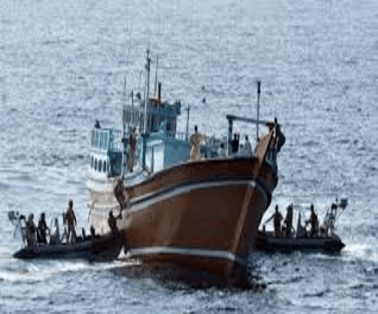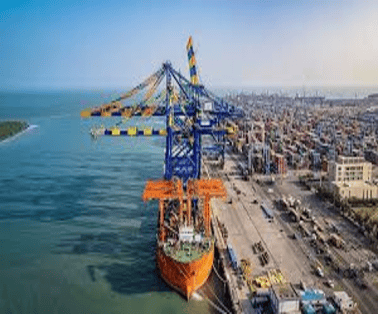Indian Navy chief Admiral R Hari Kumar recently described the Maritime Anti-Piracy Act as a “great enabler” for the Navy, particularly since piracy had long gone unregulated in Indian law. The Indian Navy apprehended 35 Somalian pirates under the newly enacted Maritime Anti-Piracy Act, marking a significant breakthrough in maritime security.
Key Points
- Indian Navy apprehended 35 Somalian pirates using newly enacted Maritime Anti-Piracy Act
- The pirates were handed over to Mumbai police to try them under this law.
- The Indian Navy on previous two occasions had apprehended pirates around and before 2011 and brought them to India to face trial but they walked free largely due to absence of any focused law that included maritime jurisdiction within the legal system.
- The law has empowered Navy to visit boat, search and seize any suspicious vessel, craft or dhow, and very few countries have this kind of act.
- This is the largest operation done by Indian Navy in the last ten years. It lasted over 40 hours after commencing from the early hours of March 15, 2024, when INS Kolkata engaged MV Ruen in the Arabian Sea, which was being used as mothership for piracy by Somalian pirates after they hijacked it in December.
Features of the Maritime Anti-Piracy Act
Applicability
- It will apply to all parts of the sea adjacent to and beyond the limits of the Exclusive Economic Zone of India.
- It will be applicable beyond 200 nautical miles from the coastline.
Piracy
- Piracy is defined as any illegal act of violence, detention, or destruction committed against a ship, aircraft, person or property, for private purposes, by the crew or passengers of a private ship or aircraft.
- Inciting or intentionally facilitating such acts would also qualify as piracy. It includes any other act that is considered as piratical under international law.
- Piracy also includes voluntary participation in the operations of a pirate ship or aircraft used for piracy.
Ship
- Defines ship as (i) vessel or water craft, and (ii) seaplanes and other aircraft capable of being used as means of transportation in water.
Personnel authorised for arrest and seizure
- Only authorised personnel may carry out arrest and seizure. These personnel include:
- officers and sailors assigned to warships or military aircraft of Indian Navy, or
- officers and enrolled persons of Coast Guard,
- officers of the central or state government authorised for any ship or aircraft.
Penalties
- An act of piracy will be punishable with: Imprisonment for life; or Death, if the act of piracy causes or attempts to cause death.
- An attempt to commit, aid, support, or counsel an act of piracy will be punishable with up to 10 years of imprisonment, and a fine.
- Participating, organising, or directing others to participate in an act of piracy will also be punishable with up to 14 years of imprisonment, and a fine.
- Offences will be considered extraditable. This means that the accused can be transferred to any country for prosecution with which India has signed an extradition treaty.
- In the absence of such treaties, offences will be extraditable on the basis of reciprocity between the countries.
- India has an agreement with Somalia where Somalian pirates have been extradited since 2017
Jurisdiction of the Courts:
- The central government, in consultation with the Chief Justice of the concerned High Court, may notify Sessions Courtsas the Designated Courts
- The Designated Court will try offences committed by:
- A person in the custody of the Indian Navy or Coast Guard, regardless of his nationality.
- A citizen of India, a resident foreign national in India, or a stateless person.
- The Court will not have jurisdiction over offences committed on a foreign shipunless an intervention is requested by: The country of origin of the ship, The ship-owner, Any other person on the ship.
- Warships and government-owned ships employed for non-commercial purposes will not be under the jurisdiction of the Court.
Disposing seized property
- The ship or property seized will be disposed of only by a Court order.
Aim of the Maritime Anti-Piracy Act
- Strengthen India’s credentials as a partner with other countries to make the world more piracy free.
- Provide an effective legal instrument to combat maritime piracy, not only in India’s territorial waters in the Exclusive Economic Zone but also on the high seas.
- Enhance India’s global credentials and strengthen maritime security
Significance of the Act
- In 2014 to 2022, 19 incidents of piracy happened in which 155 Indian crew members were involved.
- More than 90 percent of trade taking place by sea routes
- Up until now, it did not have any domestic law on maritime piracy.
- The Indian Penal Code provisions relating to armed robbery are usually used to prosecute pirates. However, this has proven to be inadequate in the past. The Gulf of Aden has seen a spurt in attacks by pirates operating from Somalia since 2008.
- This route is used by 2,000 ships each month for trade between Asia and Europe and the East coast of Africa.
International Law: UNCLOS and Piracy
- The UNCLOS, 1982 is an international agreement that establishes the legal framework for marine and maritime activities.
- It replaced the four Geneva Conventions of April, 1958, which respectively concerned the territorial sea and the contiguous zone, the continental shelf, the high seas, fishing and conservation of living resources on the high seas.
- It is also known as Law of the Sea. It divides marine areas into five main zones namely- Internal Waters, Territorial Sea, Contiguous Zone, Exclusive Economic Zone (EEZ) and the High Seas.
- It is the only international convention which stipulates a framework for state jurisdiction in maritime spaces. It provides a different legal status to different maritime zones.
- It provides the backbone for offshore governance by coastal states and those navigating the oceans.
- It not only zones coastal states’ offshore areas but also provides specific guidance for states’ rights and responsibilities in the five concentric zones.
- In 1995, India ratified the UNCLOS
To Download Monthly Current Affairs PDF Click here
Click here to get a free demo
Discover all about CLAT Exam



